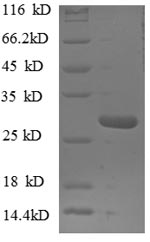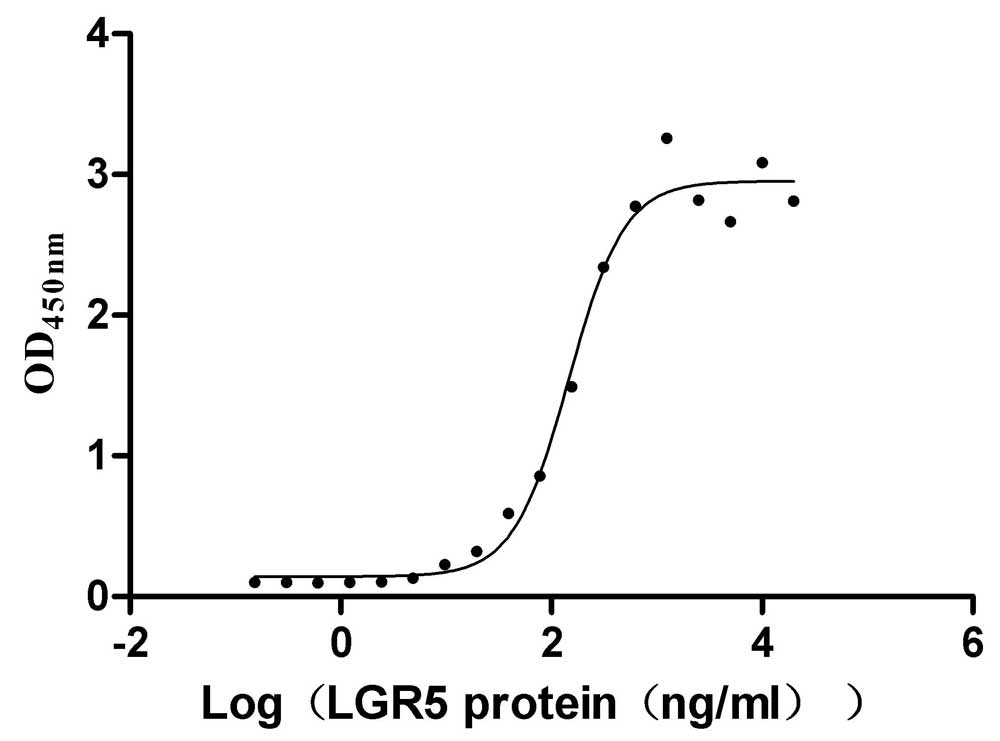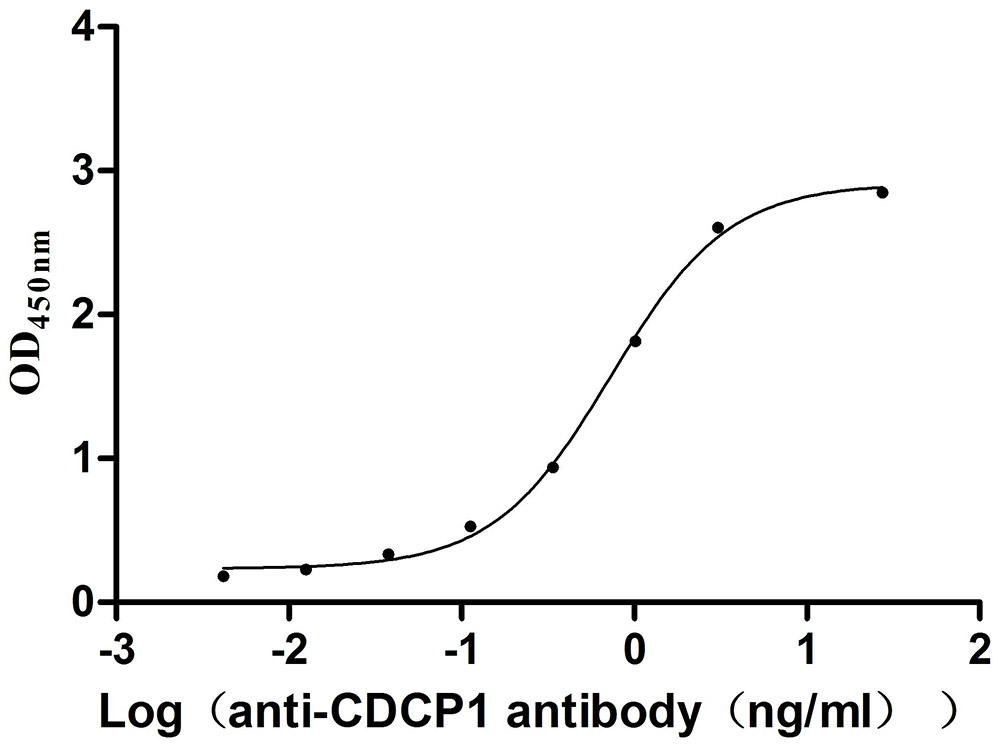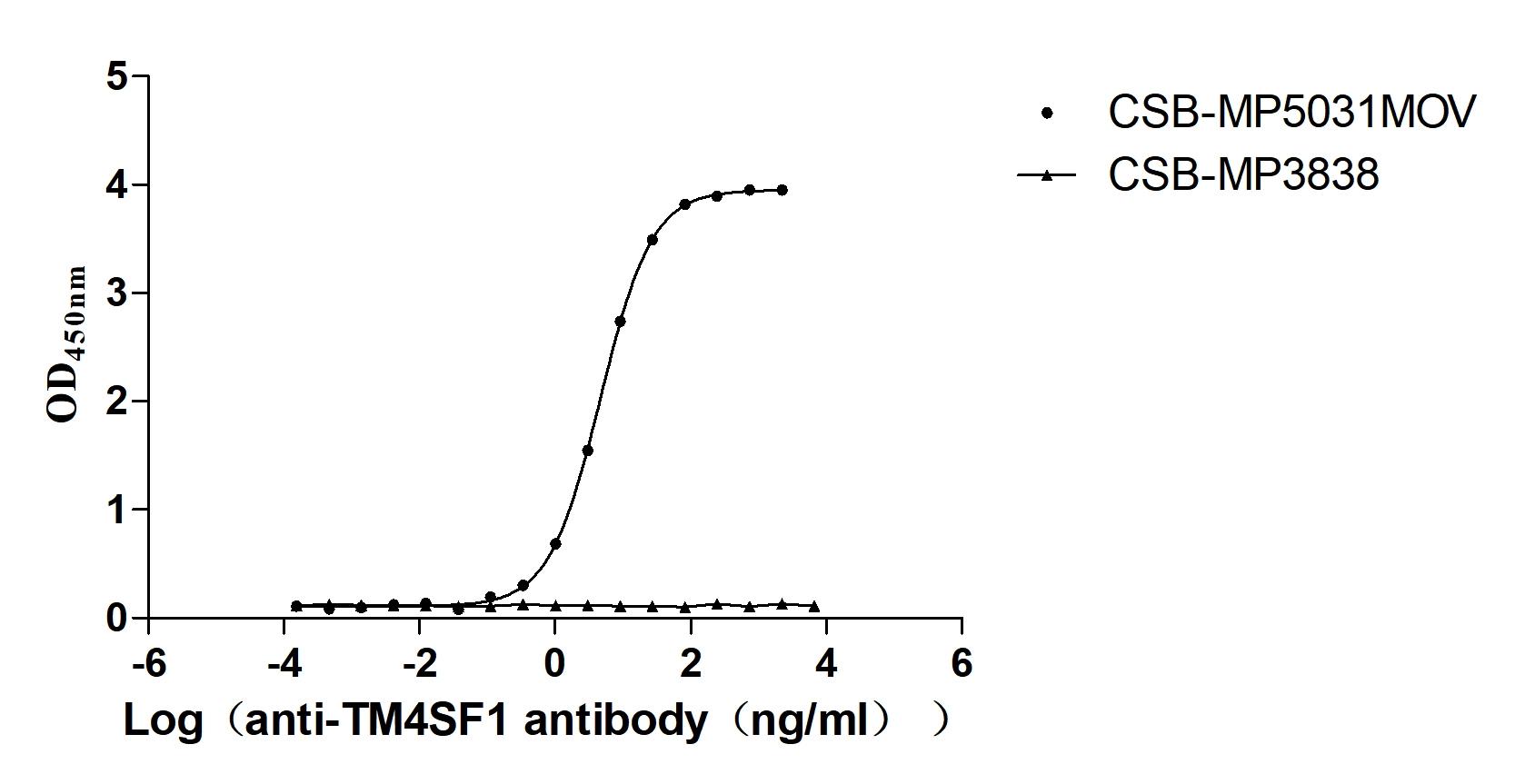Recombinant Human Nuclear pore complex protein Nup153 (NUP153), partial
-
中文名称:人NUP153重组蛋白
-
货号:CSB-EP016190HU
-
规格:¥1344
-
图片:
-
其他:
产品详情
-
纯度:Greater than 90% as determined by SDS-PAGE.
-
基因名:NUP153
-
Uniprot No.:
-
别名:153 kDa nucleoporin; HNUP153; N153; NU153_HUMAN; Nuclear pore complex protein hnup153; Nuclear pore complex protein Nup153; Nucleoporin 153kDa; Nucleoporin Nup153; Nup 153; Nup153
-
种属:Homo sapiens (Human)
-
蛋白长度:Partial
-
来源:E.coli
-
分子量:27.3kDa
-
表达区域:657-880aa
-
氨基酸序列KAGSSWQCDTCLLQNKVTDNKCIACQAAKLSPRDTAKQTGIETPNKSGKTTLSASGTGFGDKFKPVIGTWDCDTCLVQNKPEAIKCVACETPKPGTCVKRALTLTVVSESAETMTASSSSCTVTTGTLGFGDKFKRPIGSWECSVCCVSNNAEDNKCVSCMSEKPGSSVPASSSSTVPVSLPSGGSLGLEKFKKPEGSWDCELCLVQNKADSTKCLACESAKPG
Note: The complete sequence including tag sequence, target protein sequence and linker sequence could be provided upon request. -
蛋白标签:N-terminal 6xHis-tagged
-
产品提供形式:Liquid or Lyophilized powder
Note: We will preferentially ship the format that we have in stock, however, if you have any special requirement for the format, please remark your requirement when placing the order, we will prepare according to your demand. -
缓冲液:Tris-based buffer,50% glycerol
-
储存条件:Store at -20°C/-80°C upon receipt, aliquoting is necessary for mutiple use. Avoid repeated freeze-thaw cycles.
-
保质期:The shelf life is related to many factors, storage state, buffer ingredients, storage temperature and the stability of the protein itself.
Generally, the shelf life of liquid form is 6 months at -20°C/-80°C. The shelf life of lyophilized form is 12 months at -20°C/-80°C. -
货期:Basically, we can dispatch the products out in 1-3 working days after receiving your orders. Delivery time may differ from different purchasing way or location, please kindly consult your local distributors for specific delivery time.Note: All of our proteins are default shipped with normal blue ice packs, if you request to ship with dry ice, please communicate with us in advance and extra fees will be charged.
-
注意事项:Repeated freezing and thawing is not recommended. Store working aliquots at 4°C for up to one week.
-
Datasheet & COA:Please contact us to get it.
相关产品
靶点详情
-
功能:Component of the nuclear pore complex (NPC), a complex required for the trafficking across the nuclear envelope. Functions as a scaffolding element in the nuclear phase of the NPC essential for normal nucleocytoplasmic transport of proteins and mRNAs. Involved in the quality control and retention of unspliced mRNAs in the nucleus; in association with TPR, regulates the nuclear export of unspliced mRNA species bearing constitutive transport element (CTE) in a NXF1- and KHDRBS1-independent manner. Mediates TPR anchoring to the nuclear membrane at NPC. The repeat-containing domain may be involved in anchoring other components of the NPC to the pore membrane. Possible DNA-binding subunit of the nuclear pore complex (NPC).; (Microbial infection) Binds HIV-1 capsid-nucleocapsid (HIV-1 CA-NC) complexes and thereby promotes the integration of the virus in the nucleus of non-dividing cells (in vitro).; (Microbial infection) Binds HIV-2 protein vpx and thereby promotes the nuclear translocation of the lentiviral genome (in vitro).
-
基因功能参考文献:
- Nup153 is essential for the HIV-1 nuclear import in nondividing cells, and CPSF6 is important for HIV-1 integration. PMID: 29997211
- Despite the requirement of all three nucleoporins for accurate NHEJ, only Nup153 is needed for proper nuclear import of 53BP1 and SENP1-dependent sumoylation of 53BP1. Our data support the role of Nup153 as an important regulator of 53BP1 activity and efficient NHEJ. PMID: 28576968
- results further highlight the antagonistic relationship between 53BP1 and BRCA1, and place Nup153 and Nup50 in a molecular pathway that regulates 53BP1 function by counteracting BRCA1-mediated events. PMID: 28751496
- Nup153 is an epigenetic regulator which, upon altered NO signalling, mediates the activation of genes potentially associated with early dystrophic cardiac remodelling. PMID: 28513807
- NUP153 and CPSF6 have overlapping binding sites, but each makes unique capsid monomers (CA) interactions. Multiple ligands share an overlapping interface in HIV-1 capsid that is lost upon viral disassembly. PMID: 25356722
- Study assessed the extent of collapse of a Nup153 fragment in molecular dynamics simulations and compared the results to single molecule FRET and small-angle X-ray scattering experiments of this peptide PMID: 26030189
- Our data indicate a central function of Nup153 in the organization of the nucleus, not only at the periphery, but throughout the entire nuclear interior. PMID: 25485891
- Nucleoporin Nup153 is required for NPC assembly during interphase but not during mitotic exit. It functions in interphasic NPC formation by binding directly to the inner nuclear membrane via an N-terminal amphipathic helix. PMID: 26051542
- The data presented here suggest that BGLF4 interferes with the normal functions of Nup62 and Nup153 and preferentially helps the nuclear import of viral proteins for viral DNA replication and assembly. PMID: 25410863
- These data reveal an emergent Kap-centric barrier mechanism that may underlie mechanistic and kinetic control in the nuclear pore complex. PMID: 24739174
- a subset of lentiviral CA proteins directly engage FG-motifs present on NUP153 to affect viral nuclear import. PMID: 24130490
- The Nup153 binds to both SENP1 and SENP2 and does so by interacting with the unique N-terminal domain of Nup153 as well as a specific region within the C-terminal FG-rich region. PMID: 22688647
- A hydrophobic patch 65LRLFV69 within the zinc-binding domain is essential for the nuclear import and localization of HPV8 E7 via hydrophobic interactions with Nup62 and Nup153. PMID: 24418548
- The roles of NUP153 and nup98 in the integration and replication of HIV-1 in human Jurkat lymphocytes are reported. PMID: 23523133
- analysis of the Nup153-Nup50 protein interface and its role in nuclear import PMID: 23007389
- human nucleoporin 153 (NUP153) has a role in repair of DSBs and in the activation of DNA damage checkpoints. PMID: 22249246
- Nup153 binds to importin alpha PMID: 22510057
- Data show that the C-terminal part of NUP153 is required for effective 53BP1 nuclear import, and that 53BP1 is imported to the nucleus through the NUP153-importin-beta interplay. PMID: 22075984
- Nup153 levels regulate the localization of Mad1 during the metaphase/anaphase transition thereby affecting its phoshorylation status and in turn spindle checkpoint activity and mitotic exit. PMID: 21327106
- The N-terminal domain of Nup153 and its C terminus associate with the Ig-fold domain of A- and B-type lamins. PMID: 21983083
- Data suggest NUP153 plays a crucial role in the nuclear localization of the DICER1 protein. PMID: 21858095
- A significant association of a polymorphic marker (rs2328136) near the NUP153 gene (which produces a 153 kDa nucleoporin) was obtained PMID: 22118420
- results suggest that capsid, likely by the qualities of its uncoating, determines whether HIV-1 requires cellular NUP153 for PIC nuclear import PMID: 21593146
- NUP153 is a target gene of the BACH1 transcription factor according to ChIP-seq analysis in HEK 293 cells. PMID: 21555518
- Relocation of cellular proteins and inhibition of nuclear import in Hela cells during rhinovirus type 14 infection correlated with the degradation of Nup153 PMID: 12163599
- Smad2 nucleocytoplasmic shuttling by nucleoporins CAN/Nup214 and Nup153 feeds TGFbeta signaling complexes in the cytoplasm and nucleus. PMID: 12191473
- Nup153 and Nup98 have distinct domains to mediate transcription-dependent mobility PMID: 14718558
- nuclear import of the transcription factor PU.1 occurs via RanGTP-stimulated binding to Nup153 PMID: 15632149
- in vitro-translated Nup153 coimmunoprecipitate HIV-1 Vpr; Nup153 shares a unique N-terminal domain with Nup124 that is absolutely essential for Tf1 transposition PMID: 15659641
- MSL complex interacts with components of the nuclear pore, in particular Mtor/TPR and Nup153. Knockdown of Mtor or Nup153 results in loss of the typical MSL X-chromosomal staining and dosage compensation in Drosophila male cells but not in female cells. PMID: 16543150
- Nup153 zinc fingers bound GDP and GTP forms of Ran with similar affinities, indicating that this interaction is not influenced by a nucleotide-dependent conformational switch PMID: 17426026
- Although full-length Nup1p or Nup153 does not complement Nup124p, the functionality of their conserved domains with reference to Tf1 activity suggests that these three proteins evolved from a common ancestor. PMID: 17615301
- study found binding interactions with karyopherin-beta1 caused FG domains of nucleoporin Nup153 to collapse into compact molecular conformations; reversible collapse of the FG domains may play an important role in regulating nucleocytoplasmic transport PMID: 17916694
- The formation of high molecular mass complexes containing importin-alpha, Nup153 and Nup88 is increased upon oxidant treatment. PMID: 18068677
- FG-rich region of Nup153 was required to rescue defects in late mitosis PMID: 19158386
- HIV-1 integrase binds directly to nucleoporin NUP153 to mediate active nuclear import. PMID: 19369352
显示更多
收起更多
-
亚细胞定位:Nucleus. Nucleus membrane. Nucleus, nuclear pore complex.
-
蛋白家族:NUP153 family
-
数据库链接:
HGNC: 8062
OMIM: 603948
KEGG: hsa:9972
STRING: 9606.ENSP00000262077
UniGene: Hs.601591
Most popular with customers
-
Recombinant Human Poliovirus receptor (PVR) (I340M), partial (Active)
Express system: Mammalian cell
Species: Homo sapiens (Human)
-
Recombinant Human R-spondin-1 (RSPO1), partial (Active)
Express system: Mammalian cell
Species: Homo sapiens (Human)
-
Recombinant Human Interleukin-2 receptor subunit alpha (IL2RA), partial (Active)
Express system: Mammalian cell
Species: Homo sapiens (Human)
-
Recombinant Mouse Gastric inhibitory polypeptide receptor (Gipr), partial (Active)
Express system: Mammalian cell
Species: Mus musculus (Mouse)
-
Recombinant Mouse CUB domain-containing protein 1 (Cdcp1), partial (Active)
Express system: Mammalian cell
Species: Mus musculus (Mouse)
-
Recombinant Human Myosin regulatory light chain 12A (MYL12A) (Active)
Express system: E.coli
Species: Homo sapiens (Human)
-
Recombinant Macaca fascicularis Transmembrane 4 L6 family member 1 (TM4SF1)-VLPs (Active)
Express system: Mammalian cell
Species: Macaca fascicularis (Crab-eating macaque) (Cynomolgus monkey)
-
Recombinant Human Cadherin-1(CDH1),partial (Active)
Express system: Mammalian cell
Species: Homo sapiens (Human)



-AC1.jpg)

















